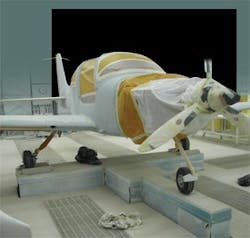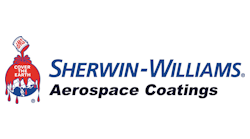What are the design differences that make an aircraft paint booth successful? This is a common question that is frequently answered incorrectly or indifferently. I will try to show some distinctions that make aircraft paint booths different from booths that are used to paint trucks, buses, cars, construction machinery, and the like.
These distinctions will suggest to the designer several different design techniques that spell the difference between success and failure.
Large equipment paint booths
Examine carefully the relationship between the product to be painted and the paint booth geometry and you will discover many subtle differences. If you look at the cross-sectional area occupied by a bus or railcar in a typical crossdraft booth, you will find that the ratio of the booth cross section (Area A2 in the figures on the right) and the product cross section (Area A1 in the figures) is about 70 to 80 percent. If a prudent designer uses an average cross-sectional velocity of 100 fpm for the booth, the velocity around the object will be four times that design velocity. This mathematical relationship is what makes the booth work correctly. Overspray is not subject to the 100 fpm velocity but to a 400 to 500 fpm velocity.
Staying, for the present, with crossdraft booths, look at the ratio of the aircraft cross section to the booth cross section. Looking at Figure 1, the aircraft cross-sectional area occupies only 15 percent of the cross-sectional area of the paint booth. If the designer uses a velocity of 100 fpm average across the booth cross section as above, the airflow over the aircraft surface (where the overspray will be found) may only be 125 fpm.
I submit that two things are in play here. The first is that 400 to 500 fpm is too high and probably leads to capture of particles that should be included in the product’s finish. The second is that 125 fpm will not do as good a job as a higher velocity. It is hard to say what the ideal velocity is for capturing overspray. Much depends on the paint and its characteristics (such as high solids vs. low solids, volatiles used, etc.). It should be obvious that there is more to work with when more of the booth is filled with product. If the actual velocity in the booth is running 400 fpm and too much overspray is reporting to the filters, it is easy to reduce the fan speed and get better performance.
What happens in a downdraft paint booth? In the large equipment example of painting a bus, the ratio of product cross section (as seen from above) is very nearly the same 75 to 80 percent as in the crossdraft booth example. Thus, the overspray collection velocity is still about 400 to 500 fpm.
Let’s look at the plan view of an aircraft (A1) in a downdraft paint booth (A2) as shown in Figure 2. You will note that the ratio is still only 20 to 25 percent in this view. However, a 5 percent increase (above the crossdraft example) on such a small number is significant and can materially affect the success of the booth, especially if combined with other design enhancements. The cross-sectional velocity may increase to 150 to 160 fpm. This is a good effect, but if a way could be found to get the airflow faster, it would work even better.
It is obvious that the booth area should be decreased to as low a number as practical to increase the ratio. This may be done by using conformal design. In this practice, the shape of the booth more closely conforms to the shape of the aircraft. For instance, aircraft are low over the fuselage and wings and are high at the tail. Installing conformably shaped surround walls that allow a slot for the tail to fit into with a low roof over the wings will reduce the booth area in a crossdraft booth and improve the area ratio. Any improvement in area ratio represents drastic improvement in overspray control.
The Bernoulli effect
The French physicist, Daniel Bernoulli, postulated a set of equations that relate the velocity of a fluid to the ratio of the areas. It simply states that with a fixed volume of air flowing through a system of varying cross-sectional area, the velocity changes in proportion to the area. This is the effect we studied above and it has an interesting corollary for the aircraft paint booth designer.
If air is introduced into the booth in such a way as to give a uniform cross-sectional velocity, the air will degrade in its journey to the exhaust end of the booth, whether crossdraft or downdraft. The causes of this degradation are the introduction of paint spray being released (causing added mass), the mass of the painter and helper, and the slow velocity of the air. At 100 fpm, the air is moving at 1.6 mph, which is slower than most people walk. It doesn’t take much of a disturbance to cause the streamlines to degrade.
The presence of the aircraft, workers, and the spray itself are all factors. Once control of the streamlines is lost, control of the overspray is lost. How do you regain control of the streamlines? Bernoulli tells you! You accelerate the air from the booth intake to the exhaust.
An intake velocity of 100 fpm must accelerate to an exhaust velocity of 150 fpm or better to overcome the challenges of streamline degradation.
Location of overspray
Most of the overspray will be within a few feet of paintable surfaces of the product (regardless of the product). Consider the differences in the product shape of a bus versus an aircraft. In most cases of poorly operating aircraft paint booths, this is a difference that was not appreciated by the designer.
If you are operating a crossdraft paint booth, the air in the booth must travel from the nose to the tail. Looked at from above (Figure 2), it is easy to see that 70 percent of the paintable surfaces are within a few feet of the fuselage. That means that 70 percent of the overspray will be within a few feet of the fuselage.
A prudent designer would look at this “spraying zone” with a critical eye and be sure to concentrate his or her efforts at controlling airflow and streamlines in the “spraying zone.” This can be controlled by careful location of the exhaust chambers. We have seen many paint booths that have exhaust chambers located in the corners of the booth. This may work well with trucks and buses but it is a disaster when the product is an aircraft. In this scenario, the air comes in at the nose of the aircraft and then splits and heads diagonally away from the aircraft to the corners, leaving large clouds of overspray hanging in the air.
An appreciation of spraying zone dynamics is essential to a successfully implemented design.
It is not so obvious with downdraft paint booths. The spraying zone appears to be a much greater area. While that is true, we can use the same principles to control overspray in the spraying zone. In this case, most of the air is directed from the ceiling to the grates in the floor over a short distance (compared with the crossdraft version). If the air is introduced in a reflected shadow of the aircraft and withdrawn in grates that occupy the shadow of the aircraft, then air is forced to move from the ceiling to the floor and hug the surfaces of the aircraft.
Or will it? While it is easy to say this, the reality is that the air wants to expand into the areas where there is no air being introduced. If we apply the Bernoulli effect, we can cause the air to accelerate at just the point where expansion of the air would normally take place, ruining our streamlines. Air emerging from the ceiling will follow its own streamlines for a good distance without expanding into the nearby spaces. When it wants to degrade, the designer must start to accelerate it sharply and continue to carry the increasing airspeed over the wing and under the fuselage to the exhaust grates.
Door styles for aircraft booths
Since getting air to the fuselage is so important, the use of filter doors allows the designer the greatest flexibility in aircraft booths. Used mainly in aircraft painting booths, bottom rolling filter doors are intended to give even distribution of air across the whole width of the paint booth. This affords more even distribution of air and control of airflow streamlines. The filter door also polishes the quality of the air-removing particulates.
The filter doors are often placed on open front paint booths to filter the air entering the booth and reduce contamination. In a pressurized paint spray booth, solid bottom rolling doors are placed in front of the filter doors to create a plenum space enclosed by the two doors.
The doors themselves are multi-leaf doors dividing the total spanned area into equally sized leaves. The doors are keyed to each other with metal dogs that allow the operator to open a single leaf and then open the remaining leaves consecutively.
The doors roll on embedded steel channels in the concrete floor. The wheels of the door are equipped with ball bearings for an easy gliding door. Doors can be powered optionally with a drive system (must be explosion proof) attached to the lead leaf.
The doors are also sealed with flexible seals along the top, bottom, and sides to prevent loss of air or the introduction of contaminants.
Example of design of filter door: Suppose a door must be 100 feet wide x 32 feet high. It will have a symmetrical opening with half rolling to pockets on the left and half to the right. The 50-foot doors would have five 10-foot leaves or seven 7-foot 3-inch leaves. The leaves take up about 8 inches of door depth, so five leaves would require storage space of 5 x 8 inches or 40 inches fully collapsed. A seven-leaf door would require 56 inches when fully collapsed. The 10-foot leaves will get five columns of 20- x 20-inch filters or four columns of 24- x 24-inch filters. The number of rows is 18 and 15, respectively. Total filter area is 249 and 240 square feet, respectively. In this case, the 20-inch-square filters give an edge to the filter area. At 249 square feet and 100 fpm, the 10-foot leaf can handle 24,900 cfm of air. The total door can handle 249,000 cfm at 100 fpm. The door could also be sized for velocities as high as 150 fpm.
It is also possible to use plenum filter doors, where the doors are organized in halves and then swung open. The door leaves are very thick to make a plenum space to allow air to enter the booth. The design of filtration follows a similar process to the bottom rolling doors above.
Lighting
Lighting is especially tricky in an aircraft paint booth as compared with a truck booth. In booths used to paint trucks, buses, trains, and other large equipment, the lights are close to the painted surface and it is easy to get good lighting. In an aircraft paint booth, the lights will usually be much further away from the surface, so more lighting is required to give the same intensity.
In the equipment booth, the underside of the vehicle product is not usually painted. Therefore, it is not necessary to provide lighting for the underside. In an aircraft paint booth, exactly 50 percent of the paintable surface is on the underside of an aircraft. Since it is not feasible to install lights in the floor (due to damage to and fouling of the lens), it is a design problem to get good illumination on the underside of the aircraft.
Lights may be installed in the walls, and these will help, but the distance to the aircraft centerline is much greater than a designer could wish for — a large number of fixtures on the sidewalls will not produce as good a result as you may believe. Fluorescent fixtures can throw light out to about 32 feet using T5-HO lamps. If the booth is 75 feet wide, it doesn’t leave much light at the aircraft skin.
Maintenance on “in floor” lights is very high and after overspray falls on them, the light quality quickly degrades. Cart-mounted lights get the light to the right place, but generally they get ignored as they get dirty and lose their effectiveness.
They are big!
Everything about an aircraft booth is big. That includes the floor space as well as height, doors, and air moving machinery. These things cannot be helped, so it is best to deal with them intelligently.
Floor space must accommodate the aircraft itself as well as access around the wing tips for moving access platforms and boom and scissors lifts. In business jets, this may be 10 to 12 feet around the wingtips and a similar amount on the front and rear of the plane. For smaller aircraft, access platforms are not required to paint the planes’ surfaces, so allowance for the passage of a person is the only necessity.
Smaller planes cause another concern that is not present on business jets. Painting the underside of an aircraft that is only 18 inches from the floor is a challenge to the flexibility of most painters. It is possible to add a lift for the three points of the aircraft and allow the painter to activate the lift to allow painting under the aircraft fuselage. Such a lift may also be designed to allow for the dropping of the aircraft so part of it is below grade. This makes it easier for the painter to paint the top parts of the fuselage and maybe even the empennage.
Design of tail stands is a feature that will require coordination with the spray booth designer to be sure enough space is available for the stands. Use of CAD programs to lay-in the aircraft and the stand are very helpful.
Conclusion
Aircraft booths are different! This is a distinction not appreciated by most process engineers who are purchasing a paint booth for aircraft. The sad record of poor paint booth installations does not have to be your lot in life. With the proper design and engineering techniques, a paint booth can be designed to fit your application. The designer must appreciate the differences in the shape of the object to be painted to design the optimum paint booth and painting environment.
Richard Thelen is president of Global Finishing Systems. For more information visit www.globalfinishing.com or call (800) 848-8738.


